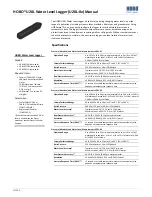
Setting Up
4-70
9161-A2-GH30-20
September 1997
Setting Up for SNMP Traps
Use the SNMP Traps Options (see
Table 4-16
) to specify the information needed
to support SNMP traps. Use the SNMP Trap Options screen to configure the
necessary configuration options needed to support the SNMP traps.
Configuration Edit/Display
→
Management and Communication
→
SNMP
Traps
To configure the T1 access unit for SNMP traps you must set:
The number of SNMP managers that are to receive SNMP traps from the T1
access unit.
An IP address for each SNMP manager specified.
The type of SNMP traps to be sent from the T1 access unit.
NOTE:
Be sure to choose an operational link for the default. Should the default link
become disabled, unrouteable traps will be discarded.
To . . .
Set the configuration option . . .
Enable sending of SNMP trap
messages
SNMP Traps to Enable.
Specify the number of SNMP
managers that will receive SNMP trap
messages from the T1 access unit
Number of SNMP Managers to the desired
number (maximum of 6) of SNMP
managers to receive SNMP traps.
Specify an IP address for each SNMP
manager specified in the Number of
SNMP Managers configuration option
NMS
n IP Address to the IP address that
identifies each SNMP manager(s) indicated
in the Number of SNMP Managers
configuration option.
Specify the network destination for
the Trap Manager
Destination to one of the following:
Default
COM
FDL
EDL (slot and port number)
Select the type of SNMP trap
messages to be sent from the T1
access unit
General Traps to enable or disable
warmStart and authenticationFailure
traps.
Enterprise Specific Traps to enable or
disable enterpriseSpecific traps.
Link Traps to enable or disable linkDown
and linkUp traps.
Link Traps Interfaces to specify which
interfaces will generate linkDown, linkUp
and enterpriseSpecific traps.
















































